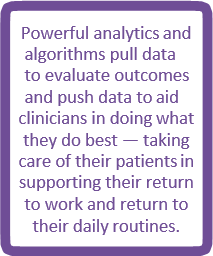This is part one of a four-part blog series on Networks in workers’ comp. Introducing Networks 2.0 Most discussions about the state of U.S. health care quickly lead to a simple but grim diagnosis: The system is broken. The evidence abounds and it’s compelling. The U.S. spends more per capita than any other country yet often produces only lackluster outcomes. Access to care can be poor. Even average life expectancy, which notched steady gains for decades, has ticked lower in recent years. But it’s not all bad news. Unpacking the state of health care reveals that not every aspect of the system is dysfunctional.

In fact, some parts have never been better. A profusion of medical research is arming clinicians with deeper insights into how the body works. Previously unimaginable treatments are poised to become commonplace. Technology is erasing sometimes enormous distances between caregiver and patient. Data analytics, including artificial intelligence, is making an impact on priorities and decisions in the system. There is another element of care delivery that’s seeing exciting reinvention: networks. In this era of rapid changes to health care, networks are becoming more important than ever. They’re evolving from relatively straightforward mechanisms for directing patients and controlling costs to collaborative partnerships between payers and providers. Call it Networks 2.0. This evolution of networks, particularly those focused on workers’ compensation, prioritize both efficacy and efficiency. The best clinicians can more easily rise to the top of the stack thanks to deeper insights into patient trajectories. In the emerging scenarios, powerful analytics and algorithms pull data to evaluate outcomes and push data to aid clinicians in doing what they do best — taking care of patients in supporting their return to work and a return to their daily routines.
How networks can help
To start, networks can continue to lean into being the best at what they’ve always done: managing the relationship with the provider. In addition, workers’ comp networks offer providers another stream of revenue that features less administrative effort. Networks can continue to work with providers to streamline administrative burdens. These steps include letting providers:
- Bill insurers directly, often electronically, thereby reducing the guesswork and the collections burden
- Grow and diversify their patient base
- Benefit from being independently credentialed
- Establish long-term relationships with patients extending beyond the care for work-related injuries or illnesses
- Support employers in their communities
- Reduce instances of coordination of benefits with multiple payers
Workers’ compensation networks are unique in other ways. The pool of injured workers goes beyond patients who might solely be served by a particular payer, for example. This allows providers to expand the reach of their practice to new segments of the community in which they operate. And when providers seek to refer injured workers to other clinicians, a network offers an extension of their current referral patterns. This paper is based on articles originally published by WorkCompWire on October 29, 2019 and November 5, 2019.


